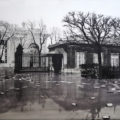MASSACRE AT MUSÉE DE LA CHASSE
Entering the exhibition is a ritual. We put on white shoe covers, like a theatre costume: the actor enters the scene. We have to bend down, bend over to pass through the door, low as those of these sacred places into which one enter by making a curtsy. We’re going in, so. The floor is covered with a grey carpet that rises on the walls and a resolutely fake light baths this unreal interior, macabre neon glare, overexposure. Bases scattered throughout the space, two shelves running on the walls. Many objects with hybrid and artificial forms, lined up there, forming great musical phrases with a thousand sounds, in rhythm, there, recompositions of nature, objects sometimes precious sometimes vulgar, that make true or false. Doubt. Sculptures created in extenso or mixed compositions, objects from multiple contexts, results of the frenetic collection of a hunter artist. We are in a cabinet of curiosities, with its share of strangeness and fantasy, of discoveries and questions. The atmosphere is experimental, like a veterinary laboratory, sometimes even a mouse trap. The domestication of the world and the constant anthropomorphisation of our environment then strikes the visitor who has become the guinea pig of a transformative experience. The spectator-consumer, as he wanders through space, becomes the animal for whom these objects for dogs or cats are now intended. Between illusion and reality, he discovers the improbable born of a world where each object has been anthropomorphised. Excessive domestication.
As awareness of humanity’s damage to nature grows, as the harmful impact of the anthropocene persists and as everyone wonders how this infernal machine will stop (can it?), Théo Mercier questions domestication at the heart of the Museum of Hunting and Nature. Explosive, the dialogue promises. Disciplined, the exhibition disappoints .
This is more or less where I stopped when I started writing this text over a month ago. Many deplore the rarity of negative writings produced by contemporary art critics. Despite the total freedom of writing that we claim within Jeunes Critiques d’Art, we do not escape this global observation. Then why? Writing requires time, energy, a personal commitment that is difficult to give to something that does not generate interest or love. It’s like having to have a drink with someone you don’t like, overall it’s a bad night. So why wasting your time? Why write about something I don’t like when so many artists interest me? Why write about this project when Théo Mercier’s other proposals arouse much more interest in me? I stopped writing, I’m going back to it because I feel the need. This text has not left me, there must be something to say.
I will not write about the exhibition, explain the reasons why the lower room fails to provoke in the visitor the reactions that the artist would like to convey and that the introductory text evokes. I will not question the hanging choices which, if they allow a good coverage on Instagram, make it difficult to lead the gaze to any depth. I will not qualify this observation by talking about the upper rooms where the dialogue between Théo Mercier and the collections makes the exhibition more convincing, although generally in vain. I’m not going to write about the exhibition, but I now understand why this text didn’t want to let me go: there is a proposal I want to talk about, wonderful.

Massacre, 2019. In a large glass display case, African masks are piled up. They were thrown there, in a jumble, like garbage abandoned at the dump, multitude of nameless bodies ditched in the mass grave. These lifeless faces pile up and get lost in a shapeless whole. We try to distinguish their features, we sometimes succeed. These masks are fake, produced by and for the European market, decorative objects for adventurous white people. We look at them and we cannot help but think of the looting, massacres and dominations that have punctuated the life of this continent. These masks – the authentic ones – were endowed with a spirit, they lived, they created links between worlds. Ripped out of their context and moved to Europe, they would die. Here, they have lost everything, so much so that they are perfectly false, simulacrum for lovers of exoticism, they testify to their pain. Every Stone Should Cry – that’s the title of the exhibition – and on the woody cheekbones of these lost faces would almost flow a tear.
Get out of your slump
Raise your face
There, around you
Look.
The masks lie in the middle of the trophy room. Like them, we are surrounded by a multitude of dead inert animals. Stuffed for their lost shine, they are exposed there. Illusive maintainings of a beauty already disappeared, paroxysm of our tendency to want to hoard everything, here they are hung on the wall. Massacre. It is also the name given to these heads of naturalized animals. Dominations are responding to each other. We keep track of it, we’re proud of it. We show our friends these trophies, whether they come from a Congolese village or from the Compiègne forest, we exhibit them. They are good memories all the same, maybe even great adventures. What anguish.
Around us nothing is alive but death.






